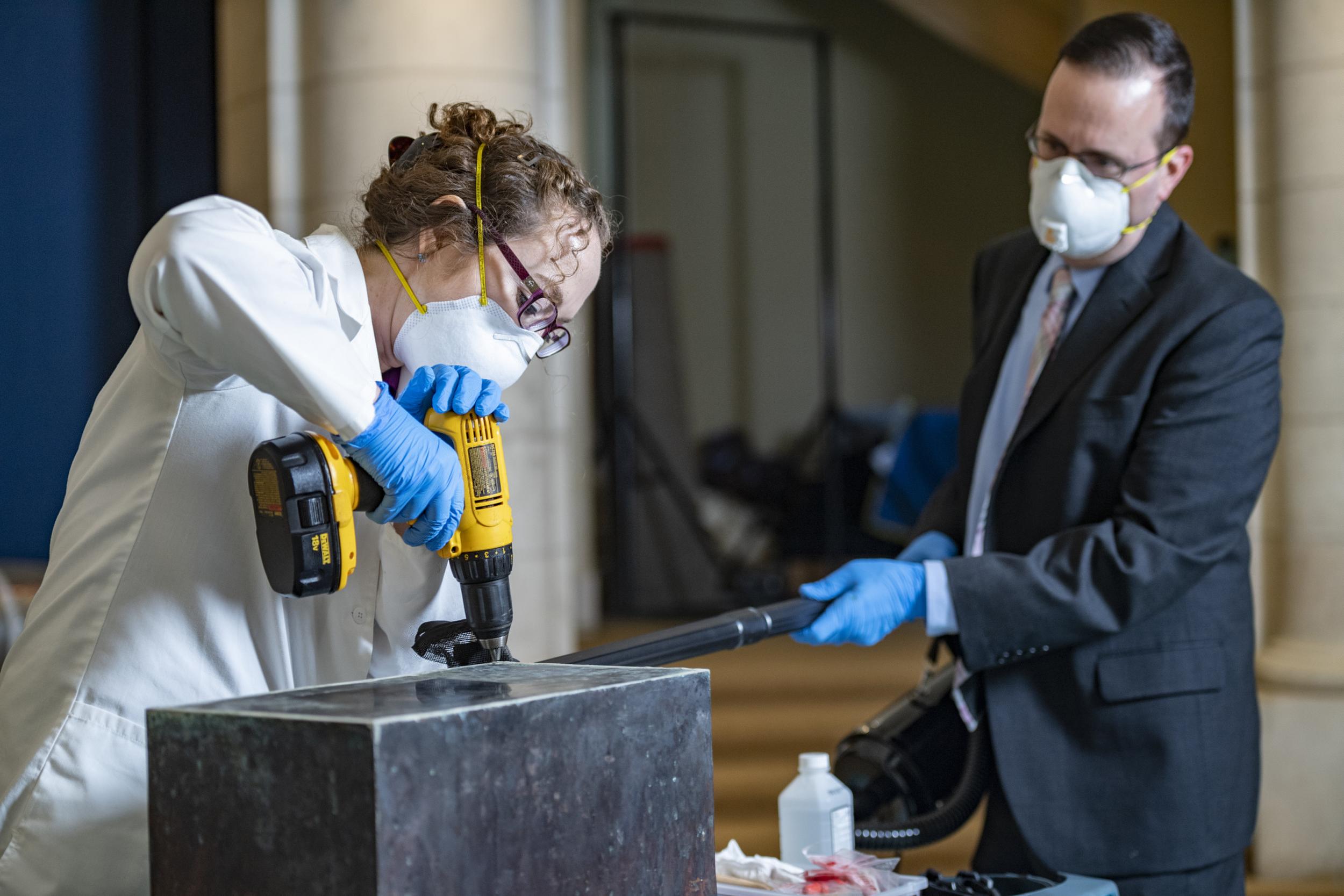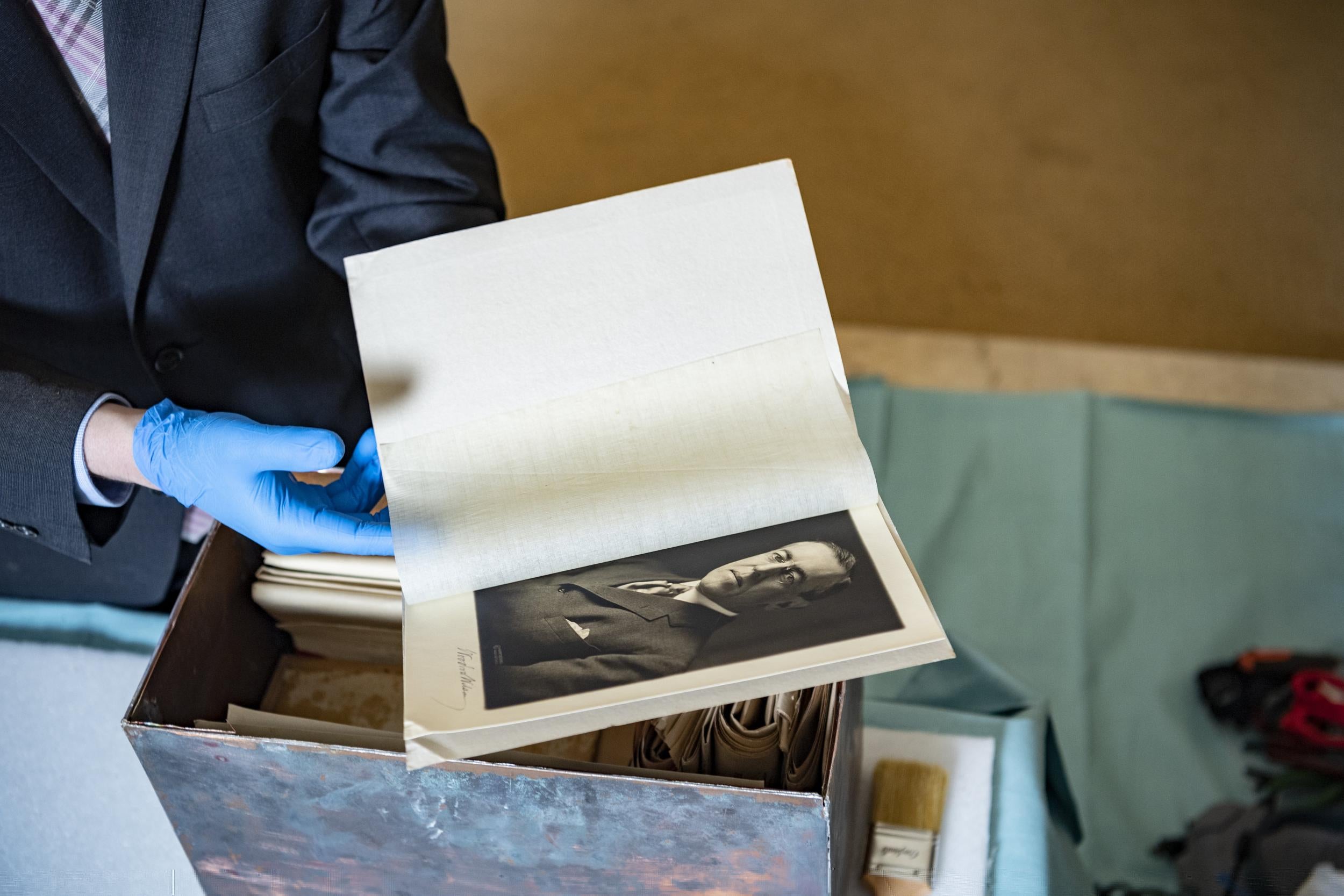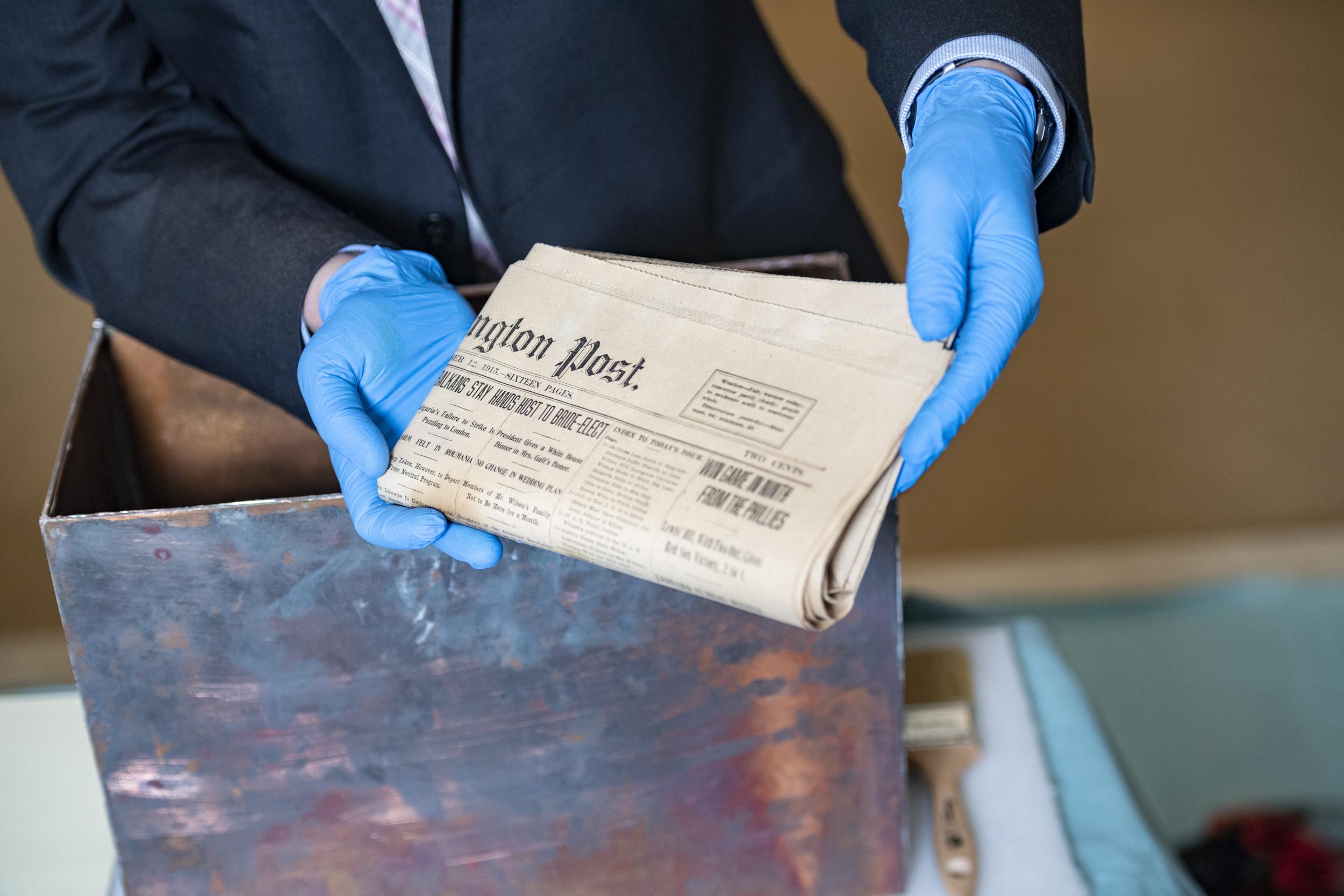Arlington Cemetery’s 105-year-old time capsule reveals lost treasures
Inside was a signed photograph of Woodrow Wilson and copies of Washington’s four newspapers from 1915

Your support helps us to tell the story
From reproductive rights to climate change to Big Tech, The Independent is on the ground when the story is developing. Whether it's investigating the financials of Elon Musk's pro-Trump PAC or producing our latest documentary, 'The A Word', which shines a light on the American women fighting for reproductive rights, we know how important it is to parse out the facts from the messaging.
At such a critical moment in US history, we need reporters on the ground. Your donation allows us to keep sending journalists to speak to both sides of the story.
The Independent is trusted by Americans across the entire political spectrum. And unlike many other quality news outlets, we choose not to lock Americans out of our reporting and analysis with paywalls. We believe quality journalism should be available to everyone, paid for by those who can afford it.
Your support makes all the difference.First, conservator Caitlin Smith carefully drilled a hole in the sealed copper box that had just been removed from the cornerstone of the century-old amphitheatre at Arlington National Cemetery.
With a special viewing scope, she peered inside. There sat another mysterious box, held with metal bands. She cut off the lid of the outer box, and historian Tim Frank lifted the inner box.
Ms Smith, wearing a white lab coat, white mask and blue surgical gloves, was nervous. She knew she might be the first person to see inside this box in 105 years. She drilled a hole and took a look.
What she saw in there was the lost world of 1915 – a signed photograph of President Woodrow Wilson, copies of Washington’s four newspapers and a programme from the 1915 “encampment” of thousands of Civil War veterans near the US Capitol.
There, too, was a tiny silk American flag, with an outdated number of stars. In 1915, there were 48 states. But this flag only had 46 stars.
“Was it sort of a last-minute add, like somebody had this flag, and it was handy, and they just kind of rolled it up and placed it in?” cemetery command historian Steve Carney wondered. “It’s something that we all have been thinking a lot about.”
Also packed inside were a thick Washington city directory, a Bible wrapped in brown paper and tied up in a red string, a copy of the congressional hearings into the amphitheatre labelled “to be put in cornerstone”, and a pamphlet labelled “Confederate Dead.”
“I tried to keep my nerves under wraps,” Ms Smith said on Monday. “I tried to be a good steady hand. We didn’t know obviously what condition things would be in. You never know if there’s going to be a surprise.”
“It was also very exciting to possibly be the first people to peek at something that hadn’t been looked at for 105 years,” she said.
The operation took place on 9 April as the cemetery marks the centennial of the elegant marble amphitheatre, which was dedicated 15 May 1920.
The amphitheatre is enclosed by a Doric colonnade, and it seats about 5,000 people for commemorations and special events honouring veterans.
Arlington officials felt it was a good time to open the time capsule, officially called a “memorabilia box”.
“It was meant to opened,” Ms Smith said. “That’s why we put time capsules in place, for future generations to remember us by. We hope we’ve done something significant enough that it will be remembered ... and we won’t be forgotten.” (Plans are to place a new time capsule this year to be opened in 2120.)

It took about 2 and a half hours to get the boxes open with metal cutting tools, Ms Smith said. Mr Frank began removing the contents one by one.
The time capsule had been removed before but not opened. It was taken from the cornerstone in 1974 when the east staircase facing the Tomb of the Unknowns was about to be added and cover the original cornerstone.
The capsule was stored at the National Archives. It was returned to the cemetery in 1976 but not installed in the new cornerstone at a different location in the structure until the 1990s during another project, Ms Smith said.
Wilson helped lay the original cornerstone on 13 October 1915, personally spreading mortar before the stone was placed, as 5,000 spectators watched and a band played the national anthem.
The time capsule had been cemented to the foundation beforehand and the hollow cornerstone was lowered over it with a crane.
The four newspapers – The Washington Post, Washington Times, Washington Star, and Washington Herald – were dated 12 October, and two still bore the stamp of a newsstand on Pennsylvania Avenue.
The Post carried a front-page story about a White House party thrown by Wilson, a widower, for his fiancee, Edith Bolling Galt, whom he would marry in December.
The United States had not yet entered the First World War, but the Post had a front-page story about the just concluded bloody Battle of Loos in France. (The United States would join the war in 1917.)
The Star had a front-page editorial cartoon by its Pulitzer Prize-winning illustrator Clifford Berryman.
The neatly wrapped Bible was signed by Thomas Hastings, the famous architect who had designed the amphitheatre.
It was marked with a thin blue ribbon at the first chapter of the Old Testament’s Book of Joshua. The experts are not sure why, but they noted that Hastings was the son of a Presbyterian minister.

The program for the Civil War veterans meeting was a guide to the 49th encampment of the Grand Army of the Republic, a large organisation of former Union soldiers. The gathering marked the 50th anniversary of the end of the war in 1865 and had run from 27 September to 2 October.
Wilson had told them on 28 September: “You set the nation free for that ... unhampered development, which the world has witnessed since the Civil War.” He had said nothing about freeing the nation from slavery.
The grey pamphlet labelled “Confederate Dead” bore an image of a Confederate flag on the cover, and the legend, “Charles Broadway Rouss Camp 1101 United Confederate Veterans Washington DC.”
Mr Carney said this was a list of locations where Confederate soldiers who had died around Washington during the war were buried. Many had since been exhumed and reburied in the Confederate section of Arlington Cemetery.
Mr Carney said that in 1915, Arlington had become a symbol of reconciliation between the North and South since the Civil War.
Wilson had told the Union veterans: “You feel, as I am sure the men who fought against you feel, that you were comrades even then.”
Mr Carney said there was almost a sense of nostalgia about the war.
“You’re really transporting yourself back,” he said. “You’re putting yourself in the mindset of those individuals in 1915 that were saying, ‘OK ... what do we put in? What makes the cut?’ “
The box is a chance “to reflect on, what was the world like in 1915,” he said.
“Within three years, the United States is a completely different place,” he said. “We’ve seen the horrors of World War I, and we’re in the midst of the Spanish influenza. What a different place and what a different memorabilia box that would have been if it was placed in 1920 when the amphitheatre was dedicated.”
The one surprise came when the capsule was removed from the cornerstone last month and a strange container was found sitting next to it.
In the 1990s, when the capsule went into the new cornerstone, there had been some extra space beside it.
Workers had seized the opportunity to add a mini time capsule of their own, Ms Smith said. They gathered their business cards, wrote some notes and searched for a handy container.
“What they found was an empty Peter Pan peanut butter jar,” she said. “It was sort of a rush job. But you can understand the impulse to add your name to history.”
The Washington Post
Join our commenting forum
Join thought-provoking conversations, follow other Independent readers and see their replies
Comments